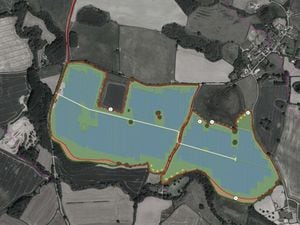Shrewsbury solar farm appeal dismissed
An appeal to develop a huge solar energy park near Shrewsbury has been thrown out after a week-long public hearing.

Energy firm Econergy International’s plan to build a 30 mega-watt solar farm on 44 hectares of land near the village of Berrington was refused by Shropshire Council in May last year – prompting the developer to launch an appeal to government planning inspectors.
The council said the loss of high grade agricultural land, and the adverse visual impact of the development meant it could not go ahead – with developers arguing back that the area already had a good supply of suitable farm land, and that the environmental benefits would outweigh any negative effects of the scheme.
The firm said the scheme could generate enough power for 7,000 homes per year over its anticipated 40-year lifespan.
But following the five-day hearing in Shirehall which saw residents of the village make an impassioned plea for the solar farm to be rejected, inspectors agreed with the council’s original decision to block the development.
Government planning inspector David Rose said that while there was a planning case for developing a solar farm on the site, the proposal would be in conflict with the council’s development plan, adding that it would “fracture” the continuity of the local countryside.
“To my mind, the perception of a retained agricultural use would be minimal as a significant part of the appeal site would be dominated by the proposed solar panels and related infrastructure,” he said.
“The appeal site would take on a wholly different character, and the nature and scale of the development would inevitably diminish the openness of the landscape, by spreading an incongruous form of development across a wide swathe of countryside, and fracturing its continuity.
“Even with the benefit of intended mitigation, the proposed development would have a significant adverse impact on landscape character at the local level.”
At the inquiry in March, resident group “Flour not Power” had outlined their concerns over the impact on the setting of several heritage assets in the area, including the Grade II listed Cantlop Bridge, which were largely dismissed by the inspector in his report.
More pressing was the effect of the development on the local Skylark population, a protected species described as having a “stronghold” in the area.
The developers had proposed providing an alternative site for the Skylarks nesting grounds, which the council and the residents group said was not sufficient.
“I am in no doubt that the appeal proposal is likely to have a significant adverse effect on a priority species, notably the Skylark which attracts significant negative weight,” added Mr Rose.
“It has also been shown that there is no satisfactory alternative means of avoiding the adverse effect through re- design or by re-locating on an alternative site.
“The nature and extent of the benefits of the proposal do not outweigh the harm that I have identified and the proposal would be in conflict with the development plan read as a whole,” the inspector concluded.





